Selected illustrations from Birk’s Comedy — Purgatorio
(All images can be located in the Chronicle Books editions.)
Purgatorio 5: Pia (Sandow Birk: Purg. 5.132-134) and (Gustave Doré: Purg. 5.133)
If Purgatory is the realm of Dante’s afterlife which most represents our life on earth then, for an American reader of the 21st century, this means an inclusion of the multiple languages, ethnicities, and faiths of an urban American existence.
We see this integration of multiculturalism on the local level in Birk’s incorporation of ethnic food establishments in his Purgatory. In his Inferno, American fast-food franchises (such as McDonalds, KFC, Starbucks, Subway, and 7 Eleven) and restaurants predominate over ethnic establishments (one only need look at the illustrations to Inf. 6 and 8). In Hell, American cuisine establishments vie with only two small signs for Vietnamese food and Chinese fast food, one falafel stand (Inf. 7), one Mediterranean food stand (Inf. 12) and one Mexican food restaurant, “El Diablito” (Inf. 24.91-93). The ratio shifts in Birk’s Purgatorio, however, as American fast food franchises disappear, save for a lone KFC that looms over the souls of the envious (Purg. 14). In Birk’s Purgatory, there is a predominance of East Asian food establishments, interrupted by the occasional presence of American bars, lounges and diners, such as “Smitty’s” lounge in the frontispiece to Purgatorio 12, the “Avarice Cafè” in Purg. 20, and “Tommy’s Joint: Sandwiches, Cocktails,” on a street corner (Purg. 23).
Along the restaurant-lined streets of Chinatown (such as the “Imperial Palace” of Purg. 5), Pia, whose dual-syllabic name with an “a” ending resonates with Chinese names of the same composition, speaks to the pilgrim and his guide. An Asian restaurant sign appears in an earlier image (Purgatorio 3), and a Mexican restaurant is visible in the frontispiece to Purgatorio 7. Beatrice, as we will learn, is Latina in Birk’s interpretation of the poem, reflecting the artist’s realistic rendering of American racial diversity.
Purgatorio 8: Guardian Angels and the Serpent (Sandow Birk: Purg. 8.96-97)
and (Gustave Doré: Purg. 8.106-108)
Birk largely maps the journey of his pilgrim up Mount Purgatory against the rolling hills of San Francisco (in addition to other cities around the world), a setting well suited to conveying the physical verticality of ascent. Here, the landscapes of the city and the bay lend themselves to the topography of land and water in Dante’s Purgatory: the Golden Gate Bridge is featured in his illustration of Purgatorio 7, where the pilgrim admires the starry skies of early nighttime. In his illustration of Purgatorio 10, Dante and the pilgrim will ascend an escalator that leads to nowhere, flanked by a sign for the BART (Bay Area Rapid Transit) public transportation system, with the Golden Gate Bridge and the Transamerica Pyramid in the distance (the latter will reappear prominently in his illustration to Purg. 24). The Golden Gate Bridge appears for a third time in his illustration to Purgatorio 17, as Dante and Vergil reach the fourth terrace.
Here, the “adversary,” or serpent, that participates in the ritual performance of temptation and exile from Eden in the Valley of the Princes, is nothing less (or more) than a Californian sea lion relaxing by the shore (Purg. 8).
Purgatorio 9: Gates of Purgatory (Sandow Birk: Purg. 9.75-77)
and (Gustave Doré: Purg. 9.81)
Just as Birk exchanges pigeons for angels in his illustrations of Paradiso, he does not allow a theologized, Christian vision to dominate the second canticle either. That Birk would substitute a Hindu temple for the gate of Purgatory in his illustration of canto 9 is one example of that effort. Christian iconography disappears in Birk’s vision of Dante’s poetic afterlife, replaced by statues of Buddha (frontispiece to Par. 11), a depiction of the Hindu god Vishnu (frontispiece to Par. 23), and Aztec art (frontispiece to Par. 33). Perhaps most surprising is Birk’s inclusion of Hinduism and Islam in the Celestial Rose itself, where, for example, the Virgin Mary is replaced by a Hindu goddess (Sarasvati). This image of the Gate of Purgatory is the first sign of Birk’s shift from a Christian framework to a non-Christian one.
Purgatorio 19: Dream of the Siren (Sandow Birk: Purg. 19.26-28)
Birk’s Purgatorio translates many features of the purgatorial experience for the souls described in Dante’s poem, particularly the need to eat, which can be seen as a reflection of the emphasis on corporeality in this canticle. Some of the other features include the sense of community and collectivity, the passage of time, and communication between the living and the dead. As highlighted by the illustration for Purgatorio 10, public transportation and mass transit convey the ideas of collectivity in the population of souls, unlike the more insular, individual modes of transportation (i.e., cars) depicted in Birk’s Inferno. Here, the pilgrim bows down before the celestial Pilot – in Birk’s world, the San Francisco MUNI, which has its destination set for “Purgatory via City of Dis” (Purg. 2). The souls of the slothful on the Fourth Terrace congregate in a huddled mass at a bus stop, where the Abbot of San Zeno gestures to Vergil and the pilgrim as if to indicate where to go (Purg. 18).
An empty airport gate for Alitalia flights to Italy (MXP/FLR) is the setting for Dante’s dream about the siren in Birk’s illustration of Purg.19. The gate is empty because it is a dream. It is interesting to note that this image does not have a counterpart in the engravings by Gustave Doré, who instead chose to illustrate verses 52-54 and verses 133-135 from this canto. In other words, Doré did not wish to illustrate the siren of Dante’s dream, whereas Birk portrays both the siren and the woman who draws Vergil’s attention to the presence of the siren, while Dante stares longingly at her. As in the case of Statius’s encounter with Vergil (Purg. 21), when characters in the poem experience a kind of dissociation, (here, Dante’s dream) Birk depicts them in a transitory setting.
Purgatorio 21: Vergil and Statius (Sandow Birk: Purg. 21. 131-133)
When Statius bows before Vergil in Birk’s illustration of Purgatorio 21.130, not only does his genuflection seem more typical of East Asian ritual, but a close look at the setting reveals that this scene takes place in Tokyo and not in San Francisco. The signs, written in Japanese characters, indicate a mass transit station on the Yamanote Line (山手線), the rapid transit loop operated by the East Japan Railway company. Birk departs from San Francisco in rendering the perspective of the kneeling Statius, here portrayed as a soul in a business suit. The emotional encounter between the two poets in Dante’s poem causes Statius to temporarily forget Vergil’s and his own “vanitate,” treating shades as one treats solid things, so Birk detours from his pilgrim’s journey in San Francisco to a location in Tokyo. The change in setting evokes the momentary forgetfulness of the immateriality of the souls’ existence in Purgatorio 21. Statius’s emotions require a change in geography to reflect the interior, emotional journey of the souls, and not the trajectory up the physical mountain. The lateral ascent up the mountain is replaced by a change in longitude; the voyage up the mountain becomes, briefly, the voyage to non-American, yet still earthly, terrain. But it is not a departure entirely from American shores; it is part of travel along a cosmopolitan network to which generations of immigrants to America belong. Specifically, Birk speaks here to immigration from the Orient, if one considers immigration from Japan and other East Asian countries to the western coast of America, which is fitting for the setting of this canticle in San Francisco. Birk visualizes the return to origins of Vergil and Statius by gesturing to the geographical distance which many Americans would travel in order to reach their own ancestral origins.
Purgatorio 25: Fires of the Seventh Terrace (Sandow Birk: Purg. 25. 109-111)
Souls in Birk’s Purgatory pass their time in much the same way that many souls on this earth do: for example, the souls of the indolent might watch videos (i.e., rented from Blockbuster, whose sign figures prominently in Purgatorio 4); or play video games in their living room (frontispiece to Purg. 23); or relax in a bar/lounge (frontispiece to Purg. 5). Indications of mass media exist in the newsstands featured in the frontispiece for Purg. 6 and in the illustration of Purg. 6, the meeting of Sordello and Virgil, where the newspapers available for sale include SF, with a headline that reads “Fires of Inferno.”
Television sets being sold in Tokyo, with ads for “Goku” (an anime character), form the fires of the lustful on the seventh terrace in Purg. 25, speaking, perhaps, to the seductions of mass entertainment.
Purgatorio 26: Arnaut Daniel (Sandow Birk: Purg. 26. 139-142)
The only character to speak in his mother tongue (Provençal) in Dante’s poem – and whose words are not translated – here (and in the verse translation) speaks Spanish, as the caption to the illustration reads. The great master of Provençal lyric speaks Spanish and works at a taco stand in Birk’s Purgatory, reminding us not only of contemporary linguistic and racial realities in America – namely, the prevalence of Spanish – but also of vernaculars other than English across the Americas. Dante includes Arnaut’s own words, in part, as a tribute to the poet and the literary tradition to which he belongs. Birk chooses Spanish for Arnaut’s words, one might hypothesize, as a tribute to the multilingual realities of life in America today.
Purgatorio 27: Garden of Eden (Sandow Birk: Purg. 27.127-130)
The potential eroticism of the Garden of Eden, where the pilgrim is entranced by the sights and sounds around him, was not lost on Birk, who chose to depict the Earthly Paradise as a strip joint (the marquee and facade are from an actual bar in San Francisco). Visitors are invited to “Take a Bite of Forbidden Fruit” in its sign, whose marquee depicts a goofy-looking snake wrapped around a semi-nude woman (Purg. 27). In his illustration to Purgatorio 28, Birk interprets Matilda’s alluring movements in a coquettish vein, casting her as a pole-dancer within the strip club Garden of Eden.
Purgatorio 29: Faith, Hope and Charity (Sandow Birk: Purg. 29. 121-123)
and (Gustave Doré: Purg. 29.121-126)
Consistent with Birk’s emphasis on diversity, are the three Graces – Faith, Hope and Charity – women with different skin tones in this illustration. They pose provocatively in bikinis and high-heeled pumps in front of a Cadillac with the license plate “3GRACE” (Purg. 29), thereby continuing the theme of an eroticized Garden of Eden (as seen in the illustrations to Purg. 27 and 28). Compare this image, if you will, with the fair damsels adorned with wreaths and full gowns in Doré’s illustration of the same verses.
Purgatorio 30 and 31: Beatrice (Sandow Birk: Purg. 30. 34-36; Purg. 31. 7-9)
and (Gustave Doré: Purg. 30.28-33)
Beatrice dresses her voluptuous body in a spare, black dress that is cut low in both the front and the back, her feet adorned with high-heeled shoes. Her condescending attitude toward the pilgrim (exemplified by her verbal tirade) is translated visually into a sassy facial expression and an indignant hand placed on her left hip in the illustration to Purgatorio 31. Birk retains her characterization while translating her mannerisms and physical appearance into current ethnic stereotypes for Latina women.
–Kristina Olson
Recommended Citation
Olson, Kristina. “Selected illustrations from Birk’s Comedy — Purgatorio.” Birk Illustrations, Digital Dante. New York, NY: Columbia University Libraries, 2017. https://digitaldante.columbia.edu/image/birk-illustrations/purgatorio/

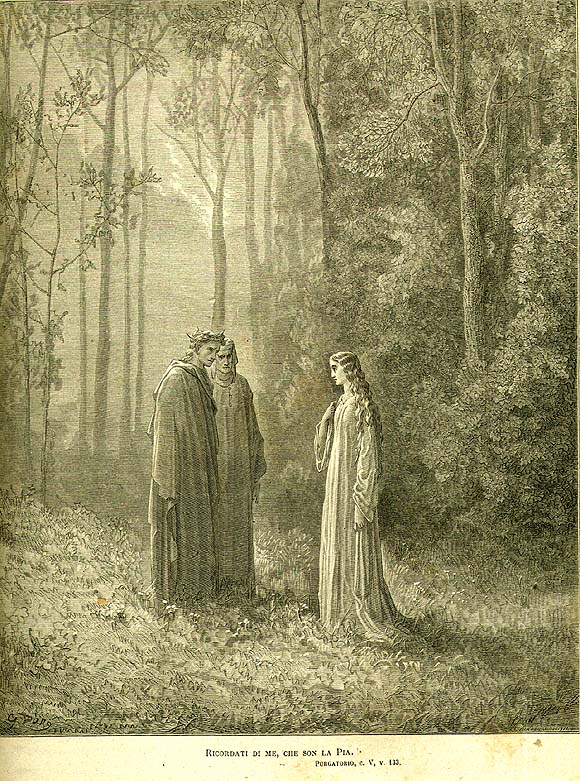
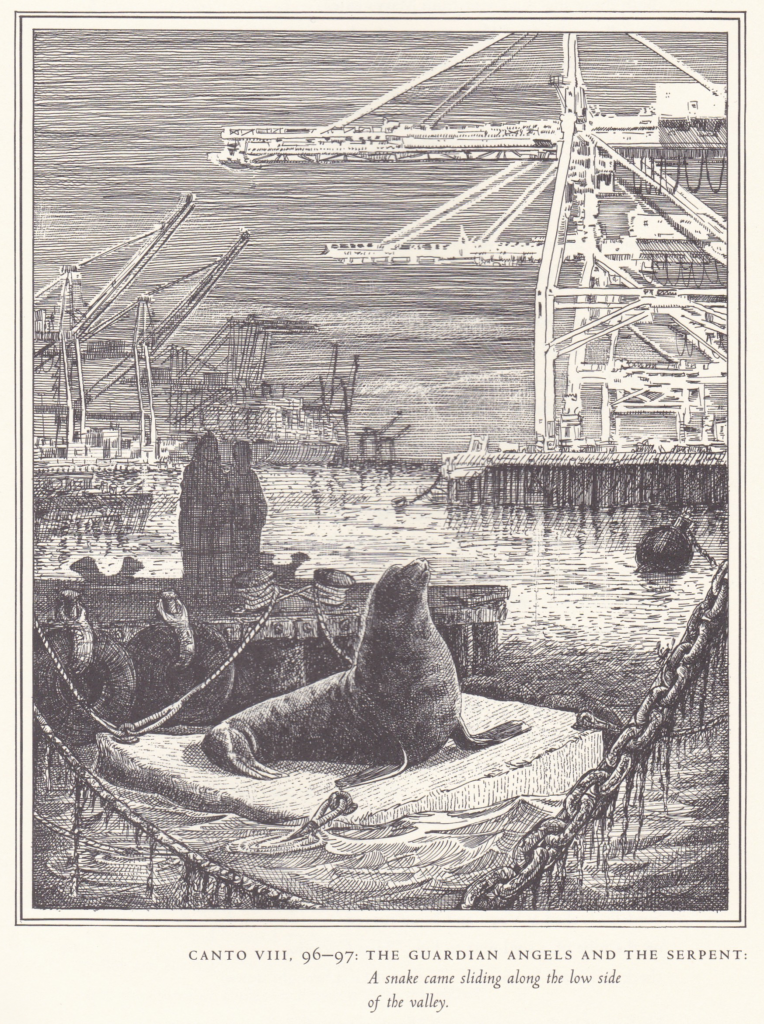
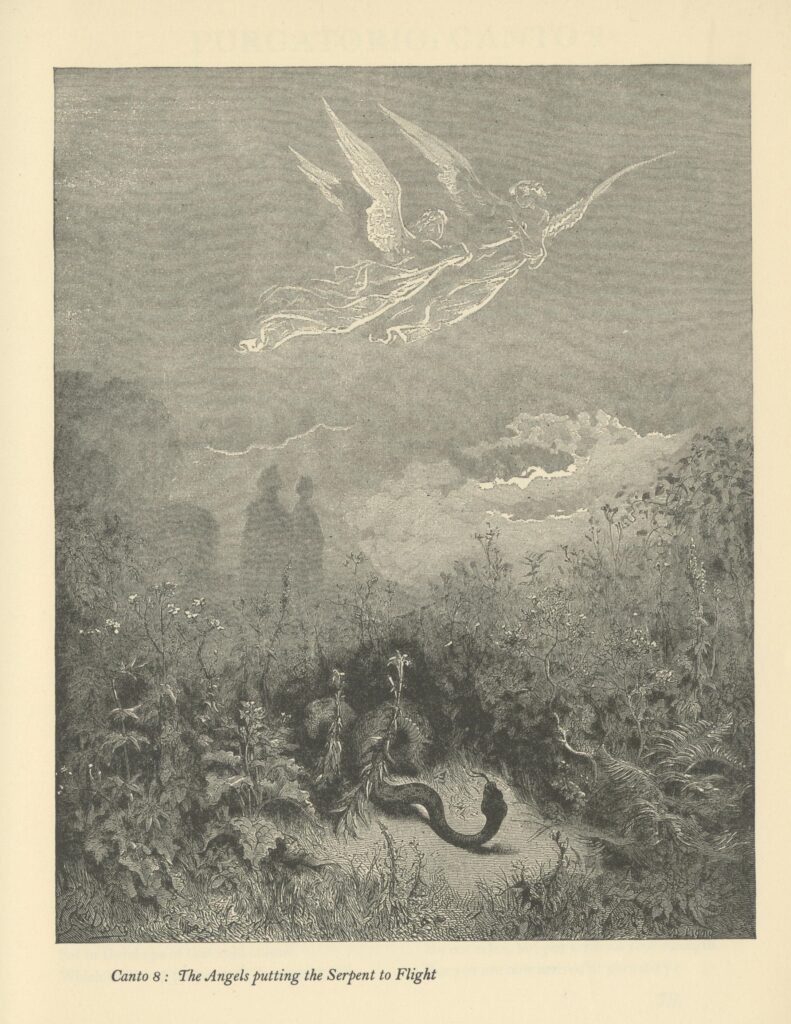
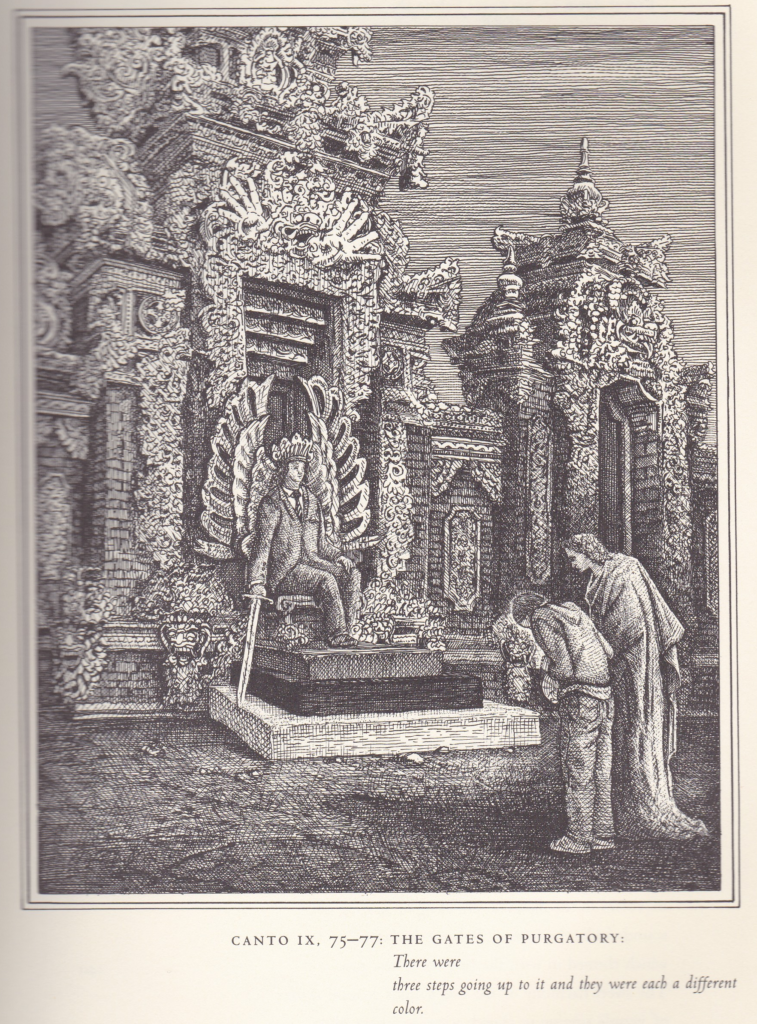
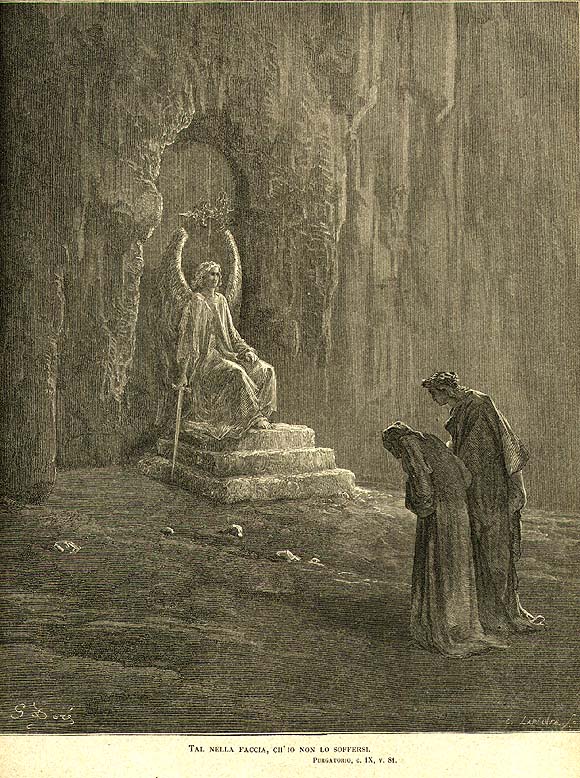
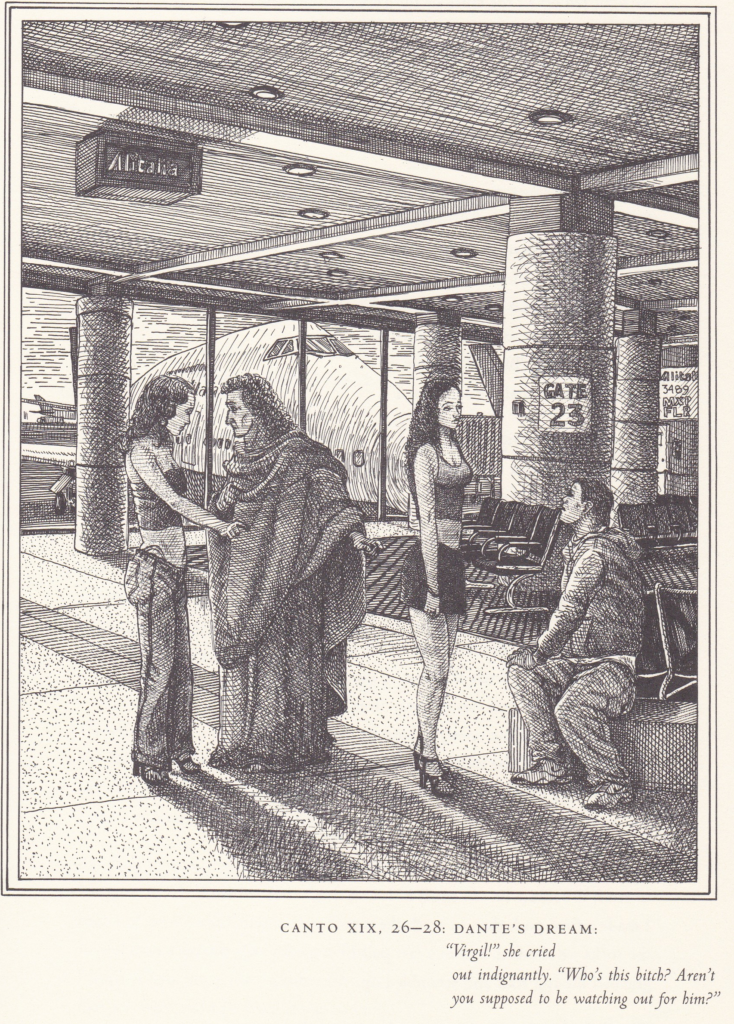
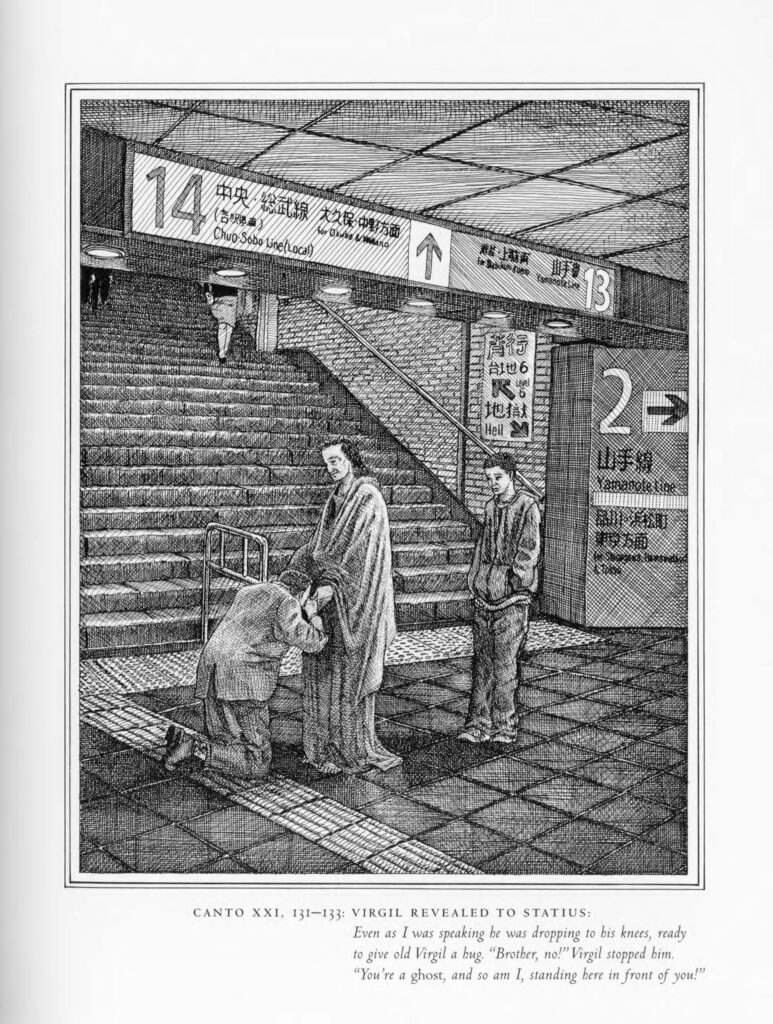
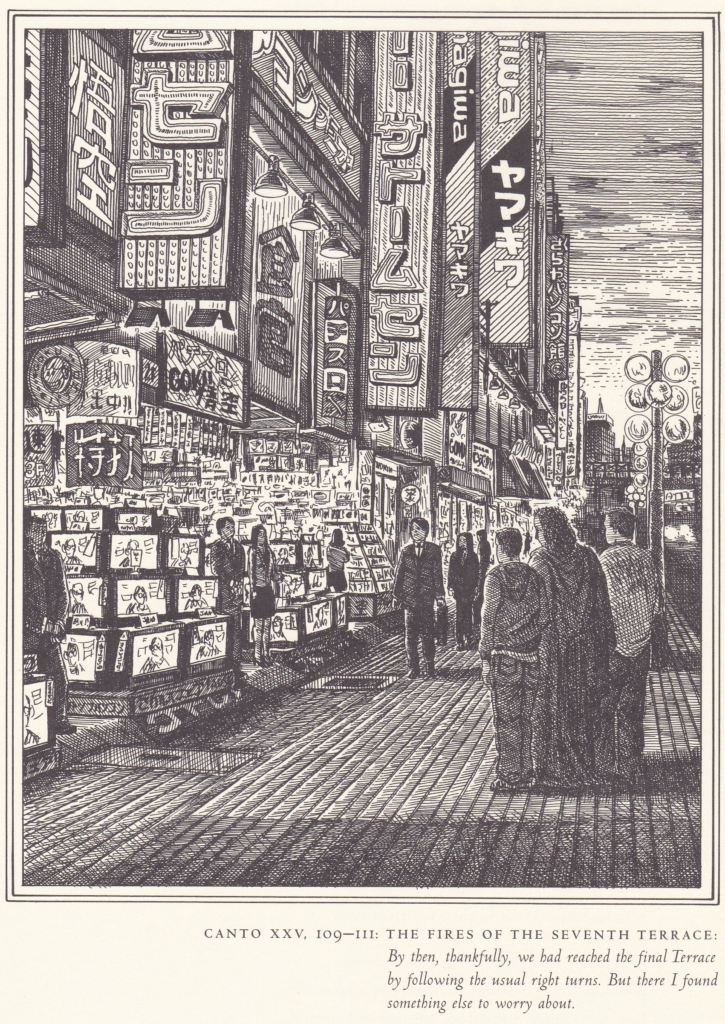
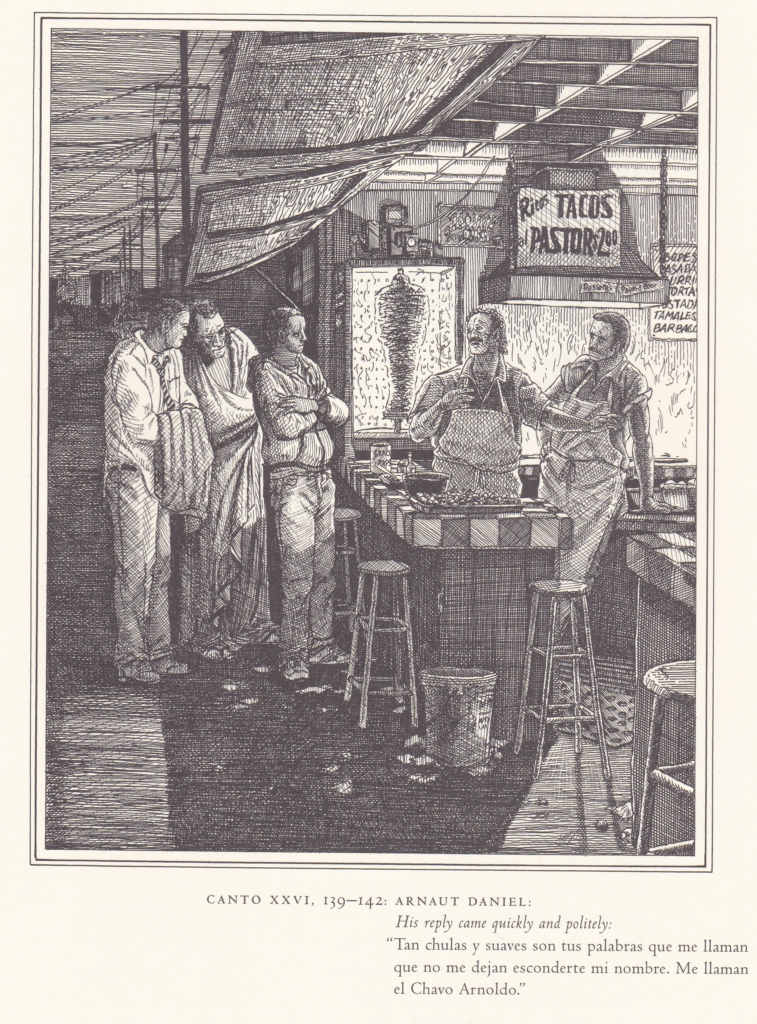
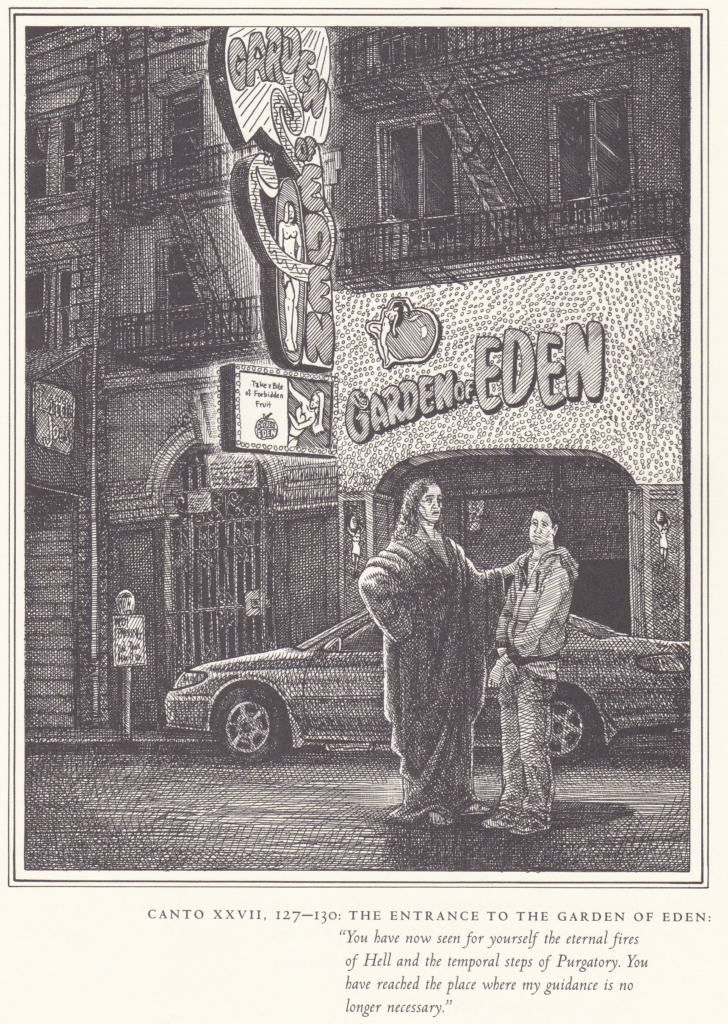
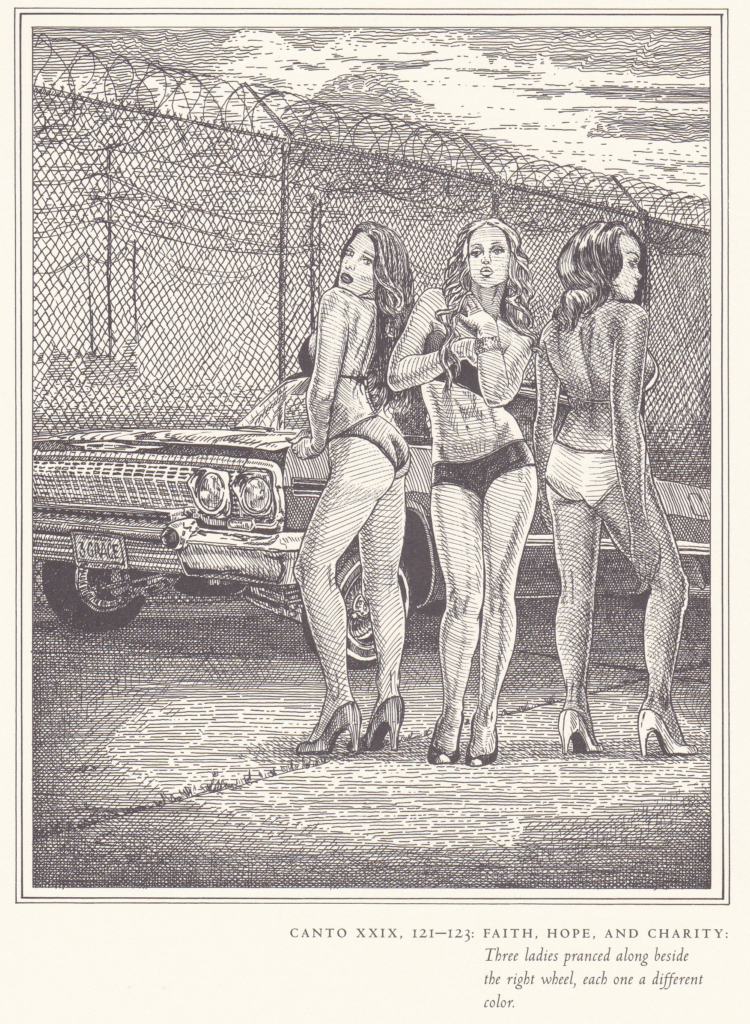
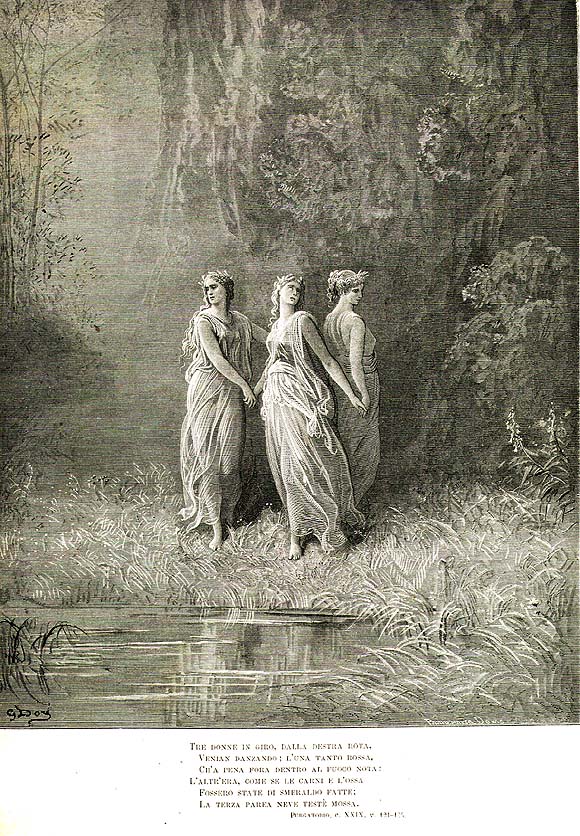
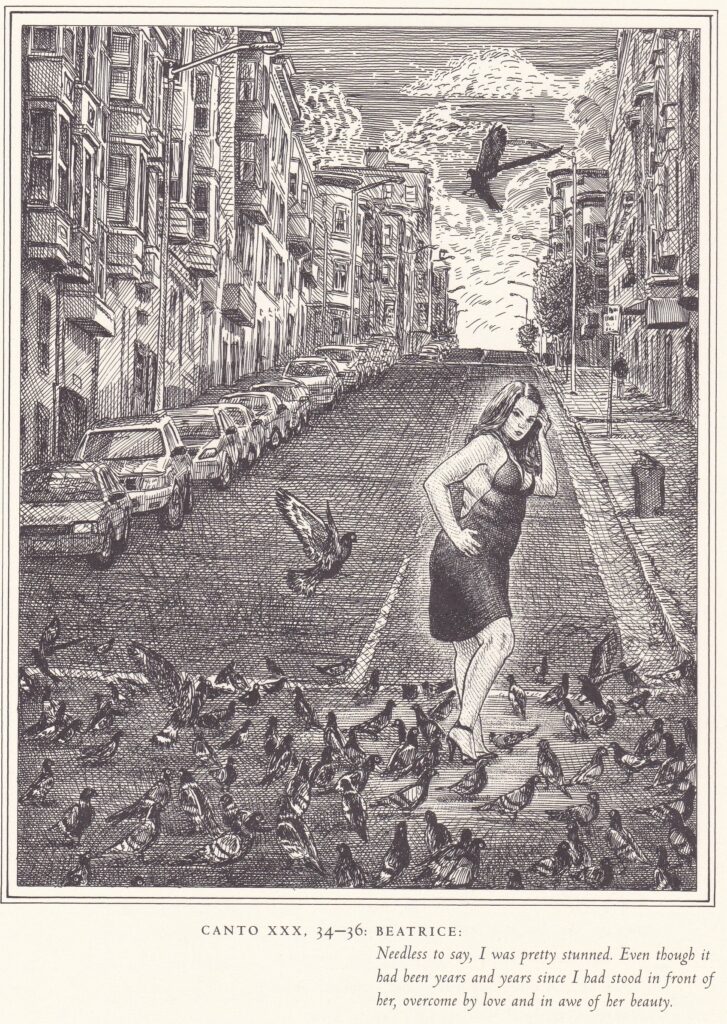
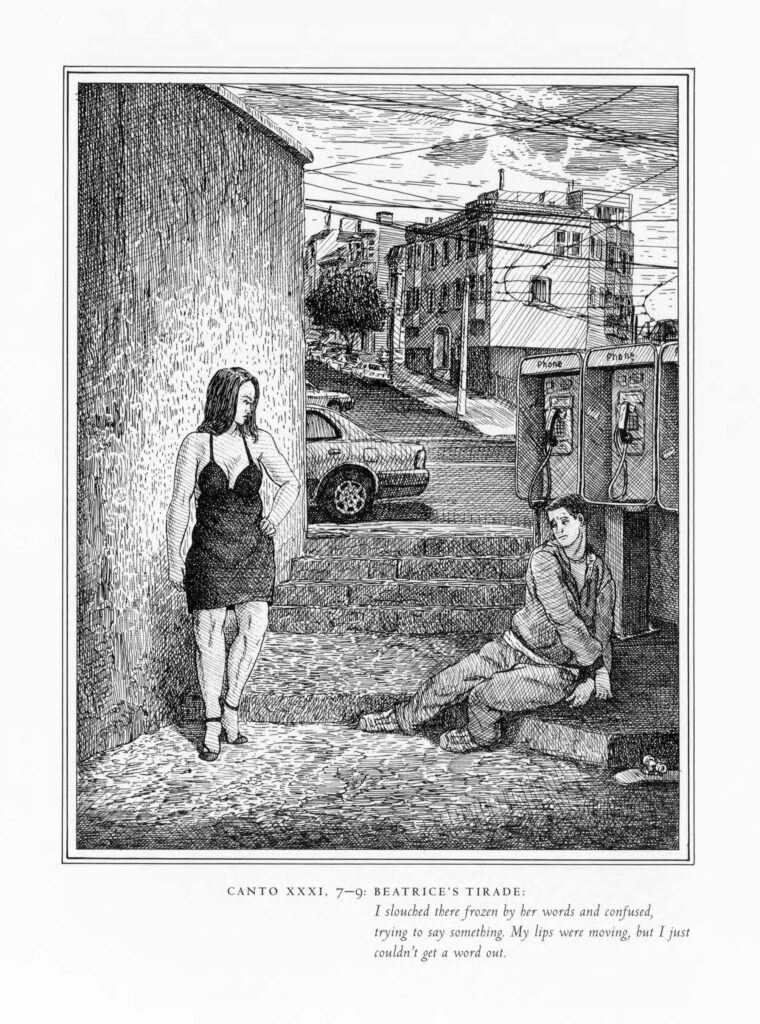
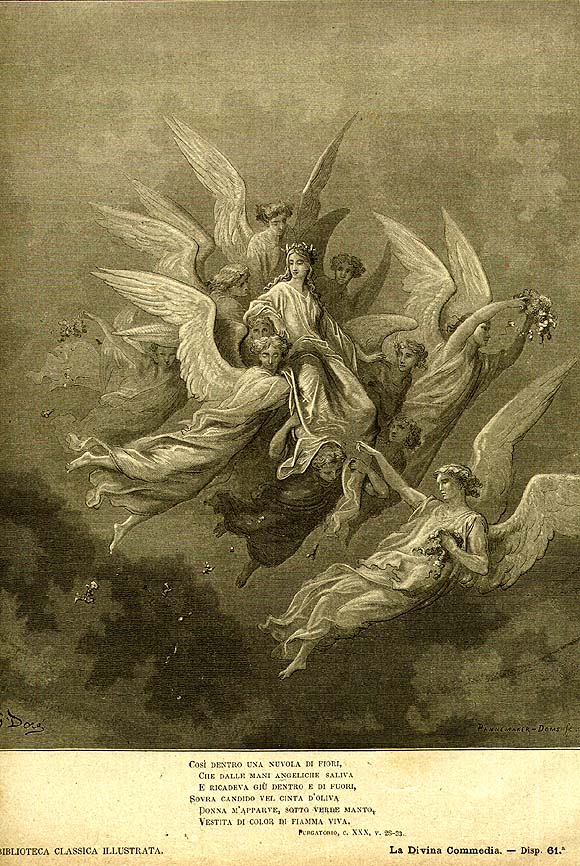
 Return to top
Return to top